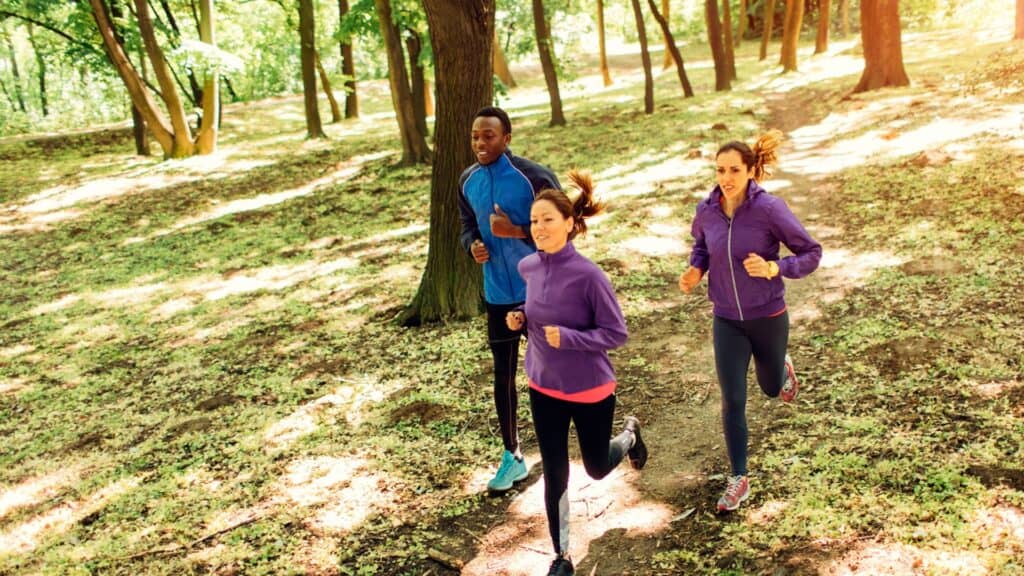Most runners may understand the differences between cross-country running and marathon running, but few may have used the different races to benefit each other
What’s even more interesting is that both types of running can benefit each other, as cross-country training can improve your marathon running and vice versa.
By understanding the differences between these two sports, and incorporating elements of both into your training, you can become a more well-rounded, and faster runner.
Marathons are 42.2km (26.2 miles) long and require endurance and speed, while cross-country races vary in length from 5-10 km (3.1-6.2 miles) and take place on varied terrain, requiring strength, endurance, and speed.
To have a better understanding of the differences between cross-country running and marathon running, we need to consider the following factors:
- Pros and cons of each race
- Training methods specific to marathon and cross-country races
- Physical and mental challenges associated with each race
- Preference for a team or individual racing
- Key strategies for success in each race.
As a bonus, we’ve got some great expert tips to help you reach your running goals and make the most out of your training. Let’s dive in!

Physical & Mental Demands Of Cross Country & Marathon Running
Both the marathon and cross-country races require significant physical and mental strength. To meet the physical demands of the race, runners must undergo proper training.
The includes:
- A variety of easy runs,
- Long endurance-based runs
- Some element of tempo/speed work (depending on your ability)
- Strength training.
Mental toughness is crucial for marathon and cross-country runners, but the demands on the mind can differ.
For instance, in a marathon, the mental challenge is more about enduring the distance and staying focused for a longer period of time. Fighting through the dark places where your body is telling you to stop and your mind tells you you can finish! The constant repetition of running on the road can be monotonous and boring, which can wear on a runner’s mental strength.
In contrast, cross-country races demand mental toughness due to the varied terrain and intensity. The race may have steep hills, muddy patches, and uneven ground that can throw off a runner’s pace and require quick decisions on foot placement. The shorter distance can also make it more challenging to maintain a consistent pace, requiring runners to dig deeper and push harder to stay competitive.
Visualizing the race beforehand and mentally preparing for the ups and downs of the race can help improve mental strength. Positive self-talk, focusing on one step at a time, and having a support system can also help runners develop mental toughness. I also like to use different mantras to repeat to myself when it’s getting tough. I’ve often written these on my arm as a reminder
With the right training and mental toughness, runners can conquer the physical and mental demands of marathon and cross-country running. But how do these two sports differ in terms of the techniques and strategies required to excel?
Training for a Marathon and Cross Country
Training for a marathon and a cross-country race both require a well-planned approach. A typical training plan lasts between 12-16 weeks and focuses on building endurance, speed, and strength. We believe in an 80/20 principle of training – where 80% of your training is endurance based and 20% will be higher intensity/speed based. The training approach for each sport shares some similarities and the principles remain, but perhaps with a few small changes around those principles
When training for a marathon, begin with a base phase focused on building aerobic capacity through regular long runs at a low to moderate intensity. This phase is critical as it allows the body to adapt to the physical demands of running for an extended period of time.
As the training plan progresses, tempo runs at a sustained, moderate to high intensity is introduced to build stamina and strength. You should also incorporate strength training workouts such as squats, hip thrusts, and eccentric calf raises throughout your 12-16 weeks of training. Strength training is important for injury prevention and overall performance.
Check out this video where we share an insanely simple, 5-exercise routine that every runner should incorporate into their strength training.
Here at Coach Parry, we’re massive advocates of strength training. We’ve put together this free strength training plan for runners that you can do once a week, at home and with no expensive equipment needed. You can access it by clicking here.
Next, focus more on speed-type workouts, such as threshold runs, which further enhance overall performance. Longer intervals at moderate to high intensity are particularly useful for building endurance and improving aerobic capacity.
In cross-country (XC) training, the focus is on building strength and speed to tackle varied terrain and unpredictable conditions. In the base phase of training, endurance is still the primary focus, and steady-state runs and hill repeats are used to develop leg strength and improve running economy, building on the foundation of endurance established in earlier training phases.
As the training progresses, the focus shifts towards interval training and tempo runs to build endurance and speed by incorporating shorter, more intense intervals to improve speed and acceleration on varied terrain.
It’s important to note that XC training requires a different approach than marathon training, as it involves running on uneven surfaces and requires quick changes of pace and direction. Therefore, incorporating a variety of training modalities, such as plyometrics and agility drills, is also essential to improving balance, coordination, and overall performance.
Understanding the training differences between marathon and cross-country is crucial for any runner preparing to take on either of these challenges. Once you have your training in place, it’s important to understand the key strategies for each type of race.
Strategy
Marathon race strategy varies depending on the race profile, as each race has its own unique challenges.

It’s recommended to start with a slower pace in the first half and gradually increase it in the second half to finish strong. This pacing strategy ensures that you don’t exhaust all your energy at the beginning and have enough left to push through the finish line.
Runners must also conserve their energy throughout the race to avoid running out of steam before the finish line. With the length of the race being so long, the pacing is crucial to ensuring a successful outcome.
See more on pacing the perfect marathon here!
In contrast to marathon racing, cross-country runners must be more adaptable to the changing terrain throughout the course. Cross-country courses can vary greatly, and runners must be prepared to adjust their pace on the fly.
During a cross-country race, uphill sections may require a slower pace to conserve energy, while downhill sections may allow runners to pick up speed, but also require the technical ability to navigate safely. Additionally, the final stretch of a cross-country race requires runners to summon the energy for a sprint to the finish line.
The ability for runners to summon the energy for a sprint to the finish line is a complex process that involves both physiological and psychobiological factors.
The psychobiological factor suggests that the brain acts as a central governor that regulates the intensity of exercise to protect the body from harm. According to this theory, the brain controls the pace at which we run to ensure that we do not exceed our physiological limits.
It does this by regulating the amount of glucose and other resources that are available to our muscles. As we approach the finish line, the brain senses that the race is almost over, and it allows more glucose to be used, which in turn allows us to sprint to the finish.
However, the psychobiology theory suggests perception of effort, motivation, and attention are among the psychobiological factors that may influence energy availability during an endurance exercise. For example, a runner who is highly motivated to perform well in a race may be able to summon more energy and push themselves harder towards the finish line, even if their physiological reserves are depleted.
Therefore, a comprehensive understanding of both physiological and psychobiological factors is necessary to fully grasp the mechanisms underlying the ability of runners to summon the energy for a sprint to the finish line. Athletes can use this knowledge to develop effective strategies that optimize performance and enhance their ability to reach peak performance during races.
How to Prepare for Race Day
Running a marathon or a cross-country race is no easy feat, but with the right preparation, you can cross that finish line with ease.
At Coach Parry, we offer customized training plans to help you reach your goals, whether it’s your first race or your tenth.
And don’t forget the importance of rest and nutrition – getting enough sleep and eating a healthy meal the night before can make all the difference.
Why Are Recovery And Nutrition As Important As Running?
As runners, we often focus on the training aspect of our sport and overlook the importance of recovery. However, recovery is just as important as training when it comes to reaching our full running potential.
Neglecting recovery increases the likelihood of injury and illness and can hinder our performance. When we exercise, we cause damage to our system on a low and healthy level. Recovery is when the body repairs this damage and makes improvements so that we can withstand more the next time we exercise.

These small improvements are what lead to increased fitness, speed, and strength. Without adequate recovery, we do not allow for the full repair and compensation of the damage caused by training.
Proper nutrition is also important for recovery, as it provides the body with the nutrients it needs to repair and rebuild muscle tissue. A diet that includes a balance of carbohydrates, protein, and healthy fats can help replenish glycogen stores, repair damaged muscle tissue, and reduce inflammation.
Is Sleep Important For Runners: FACTS To Improve Your Running: Read on to discover how a good night’s sleep can make all the difference in your race day performance.
Team vs. Individual
Marathons are usually individual events, where each runner competes against themselves and the clock, aiming to achieve a personal best time. On the other hand, cross-country races often have a team component, where runners compete not only for individual success but also for the success of their team.
While marathons and cross-country races both offer unique benefits, there are key differences between the two that runners should consider before deciding which one is right for them.
Benefits & Drawbacks of Marathons and Cross Country
Marathons offer the opportunity to test your endurance and push yourself to your limits on a flat, paved surface. They also provide a sense of accomplishment upon completing a grueling 42.2-km ( 26.2-mile) race. However, marathon training can be time-consuming, and the risk of injury is high due to the repetitive impact of running on hard surfaces. Hence, strength training is important.
Because of the distance of the marathon, you will only really get 1 chance to do well in your goal race, as you will need to have a full recovery which can take 4-6 weeks before attempting another marathon. Whereas the XC distance is a lot more forgiving because of the shorter distances, you can (with good planning) race an XC race each weekend.
Cross-country races offer a unique experience of running on varied terrain and taking in the natural beauty of the outdoors. They also provide an opportunity to participate in team events and experience the camaraderie of running with others.
However, due to the hills and uneven terrain, cross-country races can be more challenging and increase the risk of injury compared to marathons. Proper training and preparation can help reduce the risk of injury and improve performance on challenging terrain.
Each type of race comes with its own benefits and drawbacks, such as testing your endurance or running on varied terrain, and requires specific training. But with the right planning and preparation, you can make the most of your race day and achieve your goals.
Expert Tips For Race Day
- Plan your travel route ahead of time, and arrive at the starting location early: This will help you avoid traffic or any unexpected road closures that may cause you to be late and will give you ample time to prepare yourself mentally and physically for the race.
- Familiarize yourself with the starting area and course map to avoid any last-minute confusion: Familiarize yourself with the course map, including any hills or turns you need to know.
- Look for the blue line on the road to follow the most direct route: Most races have a blue line, indicating the shortest route to the finish line. Following this line can help you conserve energy and stay on track.
- Do not use new equipment or nutrition on race day that you haven’t previously tested: Race day is not the time to try out new gear or nutrition. Stick to the tried and tested equipment and food that you have used during training.
- During the race, it is important to pace yourself and stay hydrated: For shorter events, you may only need to fuel up before the race. However, for a marathon, it is crucial to fuel up during the race to keep your energy levels up. Start the race at a manageable pace, and maintain a consistent pace throughout the race. Pay attention to your body and adjust your pace if necessary
- For a marathon, conserving energy, initially, will help you push through the final miles: Don’t be tempted to sprint ahead of the pack; instead, start at a moderate pace and gradually build up your speed.
Both marathons and cross-country races offer unique challenges and rewards.

The best option for you would be to use them in conjunction with each other to gain their maximum benefits, this depends on your goals and preferences. By following proper training techniques, you can achieve success in either type of race.
Remember, while training and commitment are critical, enjoying the process is the most important thing. So, put on your running shoes, hit the road or trail, and discover where your love for running can take you.



Comments are closed.